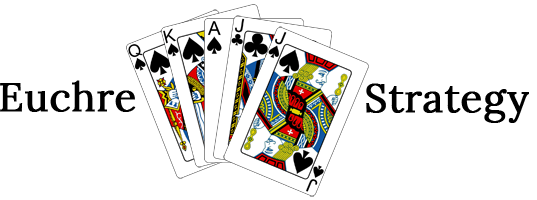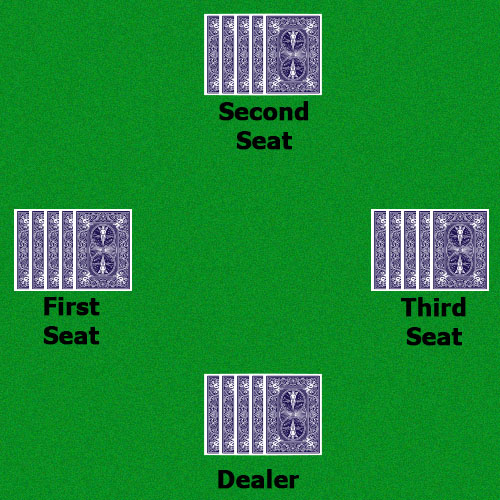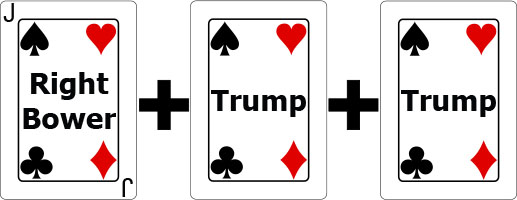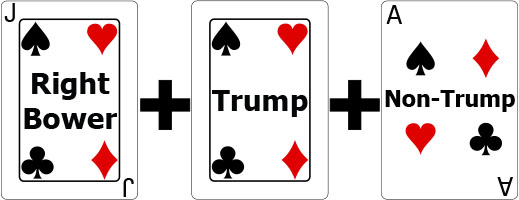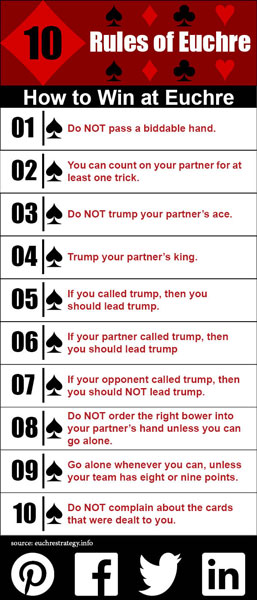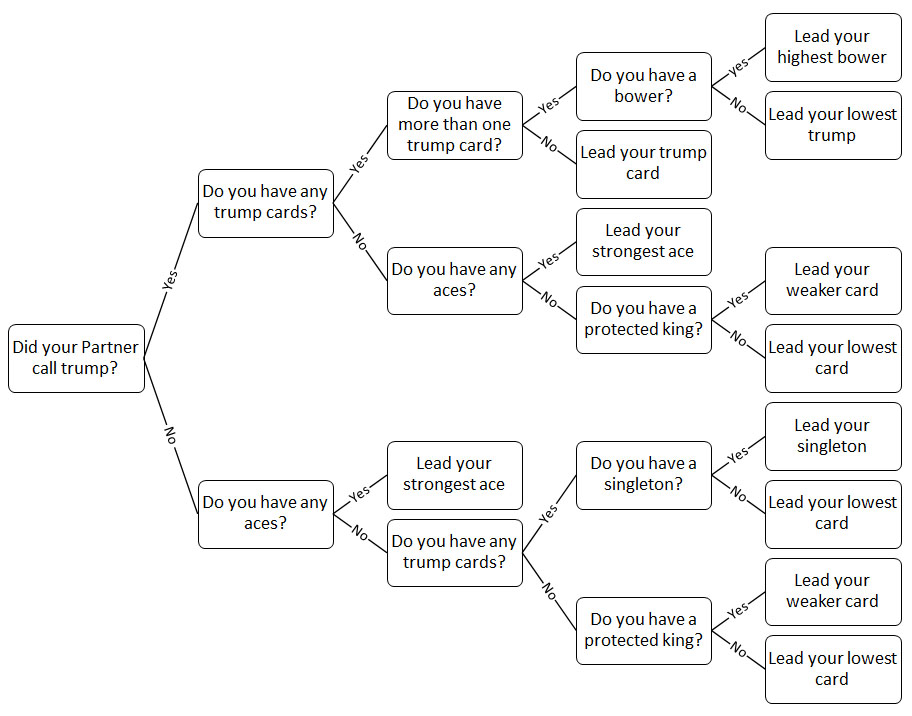Euchre is a fun social trick-taking card game where subtle calculation and a little luck can determine the winner. Euchre is played by four people in two partnerships sitting directly across from each other. The objective of the game is to be the first partnership to score 10 points.
The Euchre Deck
Euchre uses a deck of 24 playing cards consisting of Ace, King, Queen, Jack, 10, and 9 in all four suits.
 |
 |
 |
 |
 |
 |
 |
 |
 |
 |
 |
 |
 |
 |
 |
 |
 |
 |
 |
 |
 |
 |
 |
 |
Players
Four players playing in a fixed partnership.
Objective
The goal is to win at least three tricks per hand. If the side that fixed the trump fails to get three tricks, it is said to be “euchred.” Be the first partnership to score 10 points wins the match.
Trump Suit and Card Rank
The highest trump is the jack of the trump suit, called the “right bower.” The second-highest trump is the jack of the other suit of the same color called the “left bower.” For example (see table), if spades are trump, the right bower is Jack of spades and left bower is Jack of clubs. The remaining trumps, and also the plain suits, rank as follows: Ace (high), King, Queen, Jack, 10, 9.
Spades Trump |
Clubs |
Hearts |
Diamonds |
 |
 |
 |
 |
 |
 |
 |
 |
 |
 |
 |
 |
 |
 |
 |
 |
 |
 |
 |
 |
 |
 |
 |
|
 |
|||
The Euchre Table and Setup
Partners sit directly across from each other. In the diagram, North and South are playing against East and West. Euchre players traditionally keep score by using some of the remaining cards from the deck, typically the 6’s and 4’s. Each pip represents a point, and one card is used to cover the other so as to expose the number of pips corresponding to the team’s score. The scorecards are placed at the corners of the table, and one partner is assigned to keep track of the score.
Picking a Dealer
Players may randomly select a person to be the first dealer. In subsequent hands, the deal is rotated clockwise. After shuffling the cards, the dealer must offer the player to the right an opportunity to cut the deck. If the dealer fails to offer a cut to the player, the opposing team may call a misdeal as long as the cards are still being dealt or no play on the hand has been made.
The Deal
After a dealer has been selected, five cards will be dealt face-down to each player. The dealer will deal clockwise until all the players received their five cards. Traditionally, the cards are dealt in pairs of twos and threes. For example:
| 1st Player | 2nd Player | 3rd Player | 4th Player (Dealer) | |
| First Pass | 3 cards | 2 cards | 3 cards | 2 cards |
| Second Pass | 2 cards | 3 cards | 2 cards | 3 cards |
The four remaining cards will be placed face-down in front the dealer, this is referred to as the “kitty,” and the top card is turned face up. The card turned face-up is called the upcard.
First Round of Bidding and Making Trump
Play starts to the person sitting to the left of the dealer, and the upcard determines the trump suit for the first round of bidding. Each player will either “pass” or accept the trump suit by telling the dealer to pick up the card. The dealer can turn the card face down signifying that the dealer has passed, or the dealer can pick up the card by accepting the trump suit. If the dealer picks up the card, he will then discard one card from his hand.
If all four players pass, the second Round of Bidding will begin.
Second Round of Bidding
Each player, in turn, can name trump or pass. The suit named to be trump must be different than the suit of the upcard. As soon as a trump is named, the play will begin with the person sitting to the dealers left.
If all four players pass in the second round of bidding, then it is a misdeal, and the deal is passed clockwise. In some games, players enforce “screw the dealer” or “stick the dealer”, where the dealer cannot pass and must name a trump suit.
Going Alone
The player who chooses the trump suit by either accepting the upcard or declaring the suit in the second round of bidding may call “Going Alone” in order to score more points. This means that their partner sits out of the hand and play continues with only three players.
The Play
Once trump is made, the player to the dealer’s left begins play by leading a card. Any card may be led, and each player in clockwise order must follow suit. If a player cannot follow suit, then that player may play any card from their hand. The trick is won by the highest card in the suit led, or by the highest trump played. Please be aware, the left bower is considered a member of the trump suit and not a member of its native suit.
The player that wins the trick collects the played cards from the table and then leads the next trick. After all five tricks have been played, the hand is scored. The deal moves clockwise around the table.
Scoring in Euchre
The team that makes trump must take three tricks to earn a point. Failure to take at least three tricks is known as getting “euchred”, which earns two points for the defenders. The first partnership to score 10 points wins the game.
Scoring in Euchre |
Makers |
Defenders |
| Trump Makers in partnership win 3 or 4 tricks | 1 point | 0 |
| Trump Makers in partnership win 5 tricks | 2 points | 0 |
| Trump Maker goes alone and wins 3 or 4 tricks | 1 point | 0 |
| Trump Maker goes alone and wins 5 tricks | 4 points | 0 |
| Defenders win 3 tricks or more (Euchred) | 0 | 2 points |
Keeping Score in Euchre
Euchre players traditionally keep score by using some of the remaining cards from the deck, typically the 6′s and 4′s. Each pip represents a point, and one card is used to cover the other so as to expose the number of pips corresponding to the team’s score. The scorecards are placed at the corners of the table, and one partner is assigned to keep track of the score.
Another popular method is to use the 2’s and 3’s to keep score. Scores zero through 5 are rather self-explanatory. Point tallies for five or greater will be placed in the form of a “V” to represent the Roman numeral five. In any case, it doesn’t really matter how the scores are kept, as long as they are visible for everyone to see.
Variants
Stick the Dealer or Screw the Dealer
Stick the Dealer is a popular variation for euchre players. If all players pass during the second round of bidding, the dealer must name a suit trump. In some variations, the dealer may have the option to bid no-trump.
This variation is intended to speed up the game and encourage players to name call trump during the bidding process.
No-Trump
In this rule variation, a player, during the second round of bidding, may call No-trump. It is an option in which no suit is made trump, and the cards are ranked Ace high to nine. The player with the highest ranking card of the suit led wins the trick. In some variations, this option is only available for the dealer if the table agreed to invoke stick the dealer.
Farmer’s Hand
If a player is dealt a hand which contains three nines or three tens, that play may call out “Farmer’s Hand.” That player is then allowed to show the three cards in question and exchange them for the three unexposed cards in the kitty. If more than one player calls out Farmer’s Hand then the hand is declared a misdeal.
The purpose of this variation is to ensure a fair deal. Many euchre enthusiasts do not endorse this variation, because it takes away from the game. This variation is used as a major deterrent for stacking of the deck and other card cheats.
Ace-No-Face
If a player is dealt a hand which contains an Ace and no face cards, that player has the option to call a misdeal. The deal is then passed clockwise.
The purpose of this variation is to ensure a fair deal. Many euchre enthusiasts do not endorse this variation, because it takes away from the game. This variation is used as a major deterrent for stacking of the deck and other card cheats.
